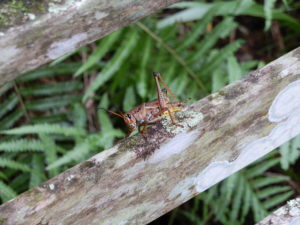
The Eastern Lubber Grasshopper (Romalea Mircroptera) also known simply as, Lubber Grasshopper, is the most identifiable grasshopper in Florida.
Stages of Lubber Grasshopper:
- Nymph Stage: smaller than adults, wingless and completely black with some yellow, orange or red stripes.
- Adult Stage: can reach 3 inches long and grow wings half the length of their body. These grasshoppers either turn a dull yellow with black spots, a bright orange with black markings, or entirely black with yellow or red striping. In the black adult phase, these grasshoppers are known as “diablo”, “black diablo”, or “devil’s horse.”

Eastern Lubber Grasshoppers inhabit the southeastern United States including west of North Carolina and Tennessee, Georgia, Alabama, Mississippi, Louisiana, Arkansas, Texas, Arizona, and Florida. These grasshoppers live in open pinewoods, in weedy vegetation, and fields. At times, they can be found in sewers or where any grass grows.
Lubbers have defense mechanisms to ensure their survival. Their brightly colored bodies have been shown to ward off predators, they also hiss very loudly and spread their wings when disturbed, and when all else fails they secrete a foul smelling and tasting acid from their thorax. This enables the grasshoppers to have long lives as most predators avoid them. However, Loggerhead Shrikes have been observed catching the grasshoppers, impaling them on barbs or thorns, and waiting a few days for the toxins to degrade in order to consume them.

Eastern Lubbers are categorically clumsy and moves quite slowly. They are unable to fly, so they primarily travel by walking as even their leaping skills are poor. Yet they are excellent climbers.
Lubber Grasshoppers can effect Florida’s economic climate since they are one of the few species of grasshoppers that can accumulate in large enough swarms to damage citrus and vegetable crops. Also, they are known to destroy many ornamental landscape plants including oleanders.
To learn more about this species of grasshopper visit: http://entnemdept.ufl.edu/creatures/orn/lubber.htm
To see pictures of the various stages of Eastern Lubbers visit: http://www.freshfromflorida.com/Divisions-Offices/Plant-Industry/Pests-Diseases/Eastern-Lubber-Grasshopper
WARNING: DO NOT TOUCH, PICK UP, OR HANDLE THESE GRASSHOPPERS
Shanna Weber

